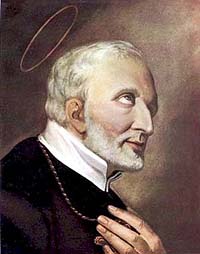In religion and mysticism

The concept of bilocation has been linked with shamanism, [6] Theosophy, [7] Islam (especially Sufism) [8] and Jewish mysticism. [9]
Hinduism and Buddhism
It is also one of the siddhis of Hinduism and Buddhism. [10] [11] Several prominent Hindu gurus, including Neem Karoli Baba, [12] Sri Yukteswar [13] and Lahiri Mahasaya, [13] have been reported to have this ability.
Christianity
The history of Christianity contains many reports of miraculous bilocations. Among the earliest of these is the apparition of Our Lady of the Pillar. This is an alleged appearance of the Virgin Mary in Caesaraugusta, Spain, in the year 40 AD, at a time when she is believed to have been still alive and living in Jerusalem. [14]
Other Christian figures said to have experienced bilocation include Catherine de' Ricci, Saint Drogo, [15] Anthony of Padua, [16] Francis of Paola, [17] Francis Xavier, [18] Martin de Porres, [19] María de Ágreda, [20] [21] Alphonsus Liguori, [5] Gerard Majella [22] and Pio of Pietrelcina. [23]
However, some Catholic philosophers disagree as to whether a person can really be physically located in two places at once, or whether the bilocations of the saints only take the form of non-substantial apparitions. [24] [25]
Witchcraft
In the 17th century, persons accused of witchcraft were often reported to appear to their victims in visions, even if they were known to be elsewhere at the time. The trials at Bury St. Edmunds and Salem included this "spectral evidence" against defendants. Matthew Hopkins described the phenomenon in his book The Discovery of Witches.
Occultism
Émilie Sagée, a French teacher working in 1845 in a boarding school in Latvia, was supposed to have had the ability of bilocation. [26]
New Religious Movements
The English occultist Aleister Crowley was reported by acquaintances to have the ability to bilocate, even though he said he was not conscious of its happening at the time. [27]
